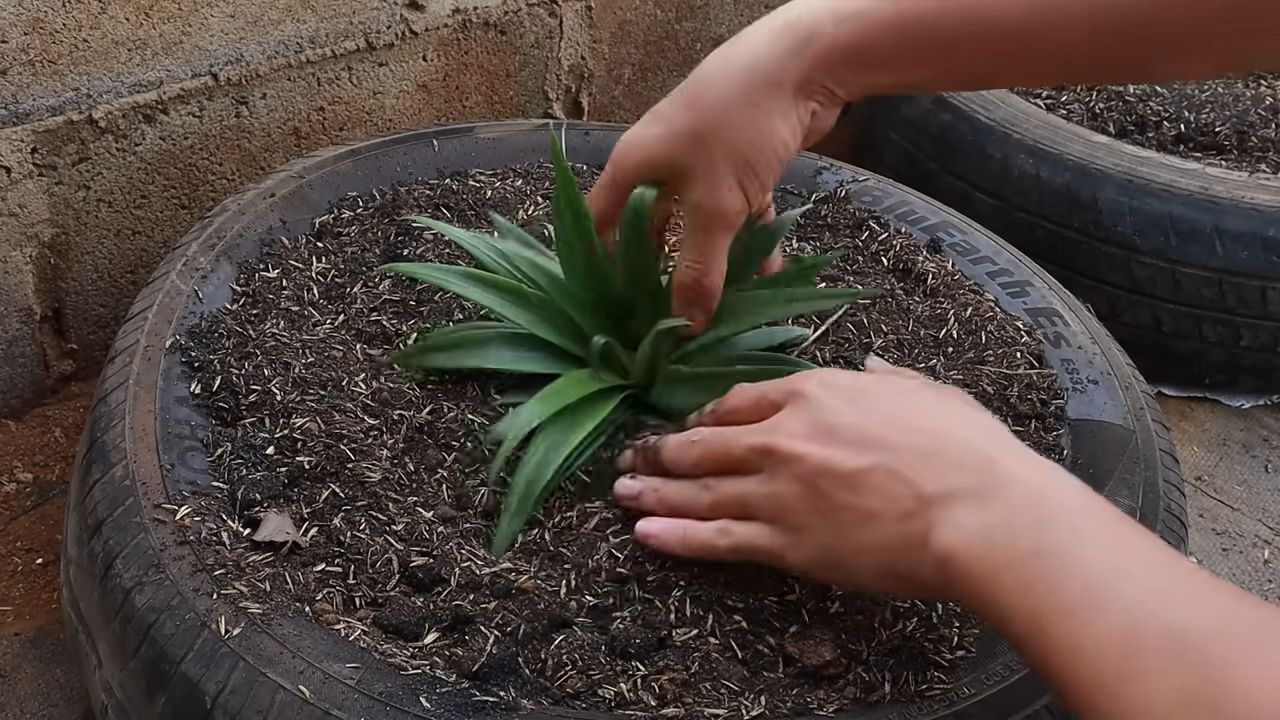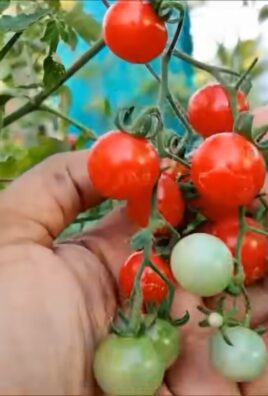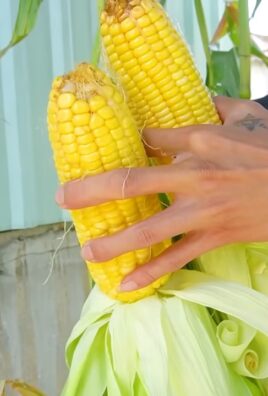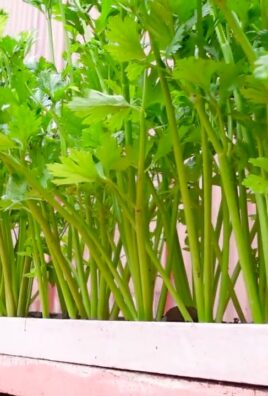Grow pineapples at home? Absolutely! Imagine plucking a juicy, sun-ripened pineapple straight from your own backyard. It sounds like a tropical dream, right? Well, it’s more attainable than you might think, and I’m here to show you how with some simple DIY tricks!
For centuries, pineapples have been a symbol of hospitality and luxury. Originating in South America, they were once so prized in Europe that owning one was a status symbol. Now, you can bring a touch of that exotic elegance to your own home, and what’s more rewarding than nurturing your own food source?
Let’s face it, store-bought pineapples can be expensive and sometimes lack that fresh, vibrant flavor. Plus, there’s something incredibly satisfying about growing your own food. This DIY guide will provide you with easy-to-follow steps to successfully grow pineapples at home, even if you don’t have a sprawling garden. We’ll cover everything from preparing the pineapple top to providing the right environment for optimal growth. Get ready to impress your friends and family with your green thumb and enjoy the sweet taste of homegrown pineapple!

Growing Pineapples at Home: A Tropical Treat You Can Cultivate Yourself!
Hey there, fellow plant enthusiasts! Ever dreamt of harvesting your own juicy pineapple right from your backyard (or even your windowsill)? Well, dream no more! Growing pineapples at home is surprisingly achievable, and I’m here to guide you through the process. It might seem daunting, but trust me, with a little patience and the right know-how, you’ll be enjoying homegrown pineapple goodness in no time.
What You’ll Need:
Before we dive in, let’s gather our supplies. Here’s what you’ll need to embark on this tropical adventure:
* A Fresh Pineapple: Choose a ripe pineapple from your local grocery store. Look for one with healthy-looking, green leaves. The fruit itself should be fragrant and slightly soft to the touch.
* A Sharp Knife: A good, sharp knife is essential for cleanly removing the top of the pineapple.
* A Pot: Select a pot that’s at least 6 inches in diameter. This will give your pineapple plant enough room to establish its roots. As it grows, you might need to transplant it to a larger pot.
* Well-Draining Potting Mix: Pineapples don’t like soggy roots, so a well-draining potting mix is crucial. A mix designed for cacti or succulents works well, or you can create your own by combining regular potting soil with perlite or sand.
* Water: Regular watering is important, but avoid overwatering.
* Sunlight: Pineapples thrive in bright, sunny locations. Aim for at least 6 hours of direct sunlight per day.
* Optional: Rooting Hormone: While not strictly necessary, rooting hormone can help speed up the rooting process.
* Optional: Gloves: Some people find the pineapple leaves irritating to the skin, so gloves can be helpful.
Preparing the Pineapple Top: The Foundation for Success
This is a crucial step, so pay close attention! We’re essentially turning the pineapple top into a viable plant.
1. Twist or Cut Off the Top: The easiest method is to firmly grasp the leaves near the base and twist the top off the pineapple. If twisting doesn’t work, use your sharp knife to carefully cut the top off, leaving about an inch of fruit attached.
2. Remove the Bottom Leaves: Gently peel off the bottom few layers of leaves from the base of the pineapple top. This will expose the stem, where the roots will eventually emerge. Be careful not to damage the stem. You should aim to expose about 1-2 inches of the stem.
3. Let it Dry (Important!): This is a step many people skip, but it’s vital to prevent rot. Place the pineapple top in a cool, dry place for 2-3 days. This allows the cut end to callous over, reducing the risk of fungal infections. I usually just leave mine on a paper towel on the kitchen counter.
Rooting Your Pineapple Top: Two Methods to Choose From
Now that your pineapple top is prepped, it’s time to encourage those roots to grow! You have two main options here: rooting in water or planting directly in soil. I’ll explain both.
Method 1: Rooting in Water
This method allows you to visually monitor root development, which can be quite satisfying.
1. Prepare a Container: Choose a clear glass or jar that’s wide enough to support the pineapple top.
2. Add Water: Fill the container with enough water to cover the exposed stem, but not the leaves.
3. Place the Pineapple Top: Carefully place the pineapple top in the container, ensuring that only the stem is submerged.
4. Find a Sunny Spot: Place the container in a bright, sunny location.
5. Change the Water Regularly: Change the water every 2-3 days to keep it fresh and prevent algae growth.
6. Wait for Roots: Be patient! It can take several weeks (sometimes even a month or two) for roots to appear. You’re looking for roots that are at least an inch long before moving on to the next step.
7. Plant in Soil: Once the roots are well-developed, it’s time to plant your pineapple top in soil. Follow the instructions in the “Planting Your Pineapple” section below.
Method 2: Planting Directly in Soil
This method is a bit more straightforward, but you won’t be able to see the roots developing.
1. Prepare Your Pot: Fill your pot with well-draining potting mix, leaving about an inch of space at the top.
2. Make a Hole: Create a hole in the center of the soil that’s large enough to accommodate the pineapple top.
3. Plant the Pineapple Top: Carefully place the pineapple top in the hole, ensuring that the base of the leaves is just above the soil line.
4. Firm the Soil: Gently firm the soil around the pineapple top to secure it in place.
5. Water Lightly: Water the soil lightly, just enough to moisten it. Avoid overwatering.
6. Find a Sunny Spot: Place the pot in a bright, sunny location.
7. Be Patient: It can take several weeks for the pineapple top to root. You’ll know it’s rooted when you see new growth emerging from the center of the plant. To test if it has rooted, gently tug on the leaves. If there is resistance, it has rooted.
Planting Your Pineapple: Giving it a Home
Whether you rooted in water or planted directly in soil, this step is where your pineapple really starts to grow.
1. Choose the Right Pot: If you started rooting in water, select a pot that’s at least 6 inches in diameter. If you planted directly in soil, you’re already set!
2. Use Well-Draining Potting Mix: Again, well-draining potting mix is key.
3. Carefully Remove the Pineapple Top: If you rooted in water, gently remove the pineapple top from the container, being careful not to damage the roots.
4. Plant the Pineapple Top: Dig a hole in the center of the pot that’s large enough to accommodate the roots (if you rooted in water) or the existing root ball (if you planted directly in soil). Place the pineapple top in the hole and gently firm the soil around it.
5. Water Thoroughly: Water the soil thoroughly after planting.
6. Find a Sunny Spot: Place the pot in a bright, sunny location.
Caring for Your Pineapple Plant: Nurturing Your Tropical Treasure
Now that your pineapple plant is established, it’s time to provide it with the care it needs to thrive.
* Watering: Water your pineapple plant regularly, but avoid overwatering. Allow the soil to dry out slightly between waterings. A good rule of thumb is to water when the top inch of soil feels dry to the touch.
* Sunlight: Pineapples need plenty of sunlight. Aim for at least 6 hours of direct sunlight per day. If you live in a climate with limited sunlight, you may need to supplement with a grow light.
* Fertilizing: Fertilize your pineapple plant every 2-3 months during the growing season (spring and summer) with a balanced liquid fertilizer. Follow the instructions on the fertilizer label.
* Temperature: Pineapples prefer warm temperatures, ideally between 65°F and 85°F (18°C and 29°C). Protect your plant from frost and freezing temperatures.
* Humidity: Pineapples appreciate humidity. If you live in a dry climate, you can increase humidity by misting the leaves regularly or placing the pot on a tray filled with pebbles and water.
* Repotting: As your pineapple plant grows, you may need to repot it into a larger container. Repotting is usually necessary every 1-2 years.
* Pest Control: Keep an eye out for pests such as mealybugs and spider mites. If you notice any pests, treat them with an appropriate insecticide or insecticidal soap.
Encouraging Fruiting: The Ultimate Goal
Getting your pineapple plant to produce fruit can take some time and patience. It typically takes 2-3 years for a pineapple plant grown from a top to produce fruit. Here are a few tips to encourage fruiting:
* Maturity: Ensure your plant is mature enough. A healthy, well-established plant is more likely to fruit.
* Ethylene Gas: Pineapples are stimulated to fruit by ethylene gas. You can try placing an apple core near the base of the plant, as apples release ethylene gas as they ripen. Cover the plant and apple core with a plastic bag for a few days to trap the gas. Be careful not to overheat the plant in the bag.
* Magnesium Sulfate (Epsom Salts): Some gardeners recommend

Conclusion
So, there you have it! Growing pineapples at home isn’t just a fun project; it’s a rewarding experience that brings a touch of the tropics right to your windowsill or garden. Forget those expensive, often bland, store-bought pineapples. Imagine the satisfaction of slicing into a juicy, sweet pineapple that you nurtured from start to finish. This DIY trick is a must-try for anyone who loves fresh produce, enjoys a bit of gardening, or simply wants to impress their friends and family with their green thumb.
Why is this method so compelling? First, it’s incredibly cost-effective. You’re essentially repurposing the top of a pineapple you would have otherwise discarded. Second, it’s a fantastic way to connect with nature and learn about the life cycle of a plant. Watching your pineapple sprout roots, grow leaves, and eventually produce fruit is an incredibly fulfilling process. Third, the taste of a homegrown pineapple is simply unmatched. The sweetness and flavor are intensified, making it a truly special treat.
But don’t stop there! Experiment with different varieties of pineapples to find your favorite flavor profile. Try growing your pineapple in different types of soil or containers to see what works best in your environment. Consider adding organic fertilizers to boost growth and fruit production. You can even get creative with your presentation by planting your pineapple top in a decorative pot or repurposing an old container.
We encourage you to take the plunge and try this DIY trick for yourself. It’s easier than you might think, and the results are well worth the effort. Once you’ve harvested your first homegrown pineapple, be sure to share your experience with us! Post photos of your pineapple plants, share your tips and tricks, and let us know how it tasted. We’re eager to hear your success stories and learn from your experiences. Let’s create a community of home pineapple growers and spread the joy of this tropical delight! Remember, mastering the art of growing pineapples at home is a journey, and we’re here to support you every step of the way.
Frequently Asked Questions (FAQ)
Q: What kind of pineapple should I use for propagation?
A: The best pineapples to use for propagation are those that are ripe and healthy. Look for pineapples with vibrant green leaves and a firm, golden-yellow body. Avoid pineapples that are bruised, damaged, or have brown or wilted leaves. The variety of pineapple doesn’t matter as much, but some varieties may be more readily available in your area. Smooth Cayenne is a popular choice.
Q: How long does it take to grow a pineapple from a top?
A: Growing a pineapple from a top is a patience game! It typically takes anywhere from 2 to 3 years for a pineapple plant to mature and produce fruit. The first few months are crucial for root development, and you’ll need to be patient as the plant establishes itself. After that, growth will gradually increase. Factors like climate, sunlight, and soil quality can also affect the growth rate.
Q: What kind of soil is best for growing pineapples?
A: Pineapples thrive in well-draining, slightly acidic soil. A mixture of potting soil, perlite, and sand is ideal. This combination provides good drainage, aeration, and nutrients for the plant. Avoid heavy clay soils, as they can retain too much water and lead to root rot. You can also amend your soil with organic matter, such as compost or peat moss, to improve its fertility and drainage.
Q: How much sunlight does a pineapple plant need?
A: Pineapples need plenty of sunlight to thrive. Aim for at least 6 hours of direct sunlight per day. If you’re growing your pineapple indoors, place it near a sunny window or supplement with a grow light. Insufficient sunlight can lead to stunted growth and reduced fruit production.
Q: How often should I water my pineapple plant?
A: Water your pineapple plant regularly, but avoid overwatering. Allow the soil to dry out slightly between waterings. During the growing season (spring and summer), you may need to water more frequently than during the dormant season (fall and winter). Check the soil moisture by sticking your finger into the soil. If it feels dry to the touch, it’s time to water.
Q: How do I fertilize my pineapple plant?
A: Fertilize your pineapple plant every 2-3 months during the growing season with a balanced, water-soluble fertilizer. Follow the instructions on the fertilizer package for proper dosage. You can also use organic fertilizers, such as compost tea or fish emulsion. Avoid over-fertilizing, as this can damage the plant.
Q: How do I encourage my pineapple plant to fruit?
A: Getting your pineapple plant to fruit can sometimes be tricky. One common method is to expose the plant to ethylene gas. You can do this by placing a ripe apple or banana near the plant and covering it with a plastic bag for a few days. The ethylene gas released by the fruit will stimulate flowering. You can also purchase ethylene-releasing products specifically designed for this purpose. Ensure your plant is mature enough (at least 2-3 years old) and has received adequate sunlight and nutrients before attempting to induce fruiting.
Q: What are some common problems with growing pineapples?
A: Some common problems with growing pineapples include root rot, mealybugs, and scale insects. Root rot is caused by overwatering and poor drainage. To prevent it, ensure your soil is well-draining and avoid overwatering. Mealybugs and scale insects are sap-sucking pests that can weaken the plant. You can control them by wiping them off with a cotton swab dipped in rubbing alcohol or by using insecticidal soap.
Q: Can I grow pineapples in containers?
A: Yes, pineapples are well-suited for container gardening. Choose a pot that is at least 12 inches in diameter and has drainage holes. Use a well-draining potting mix and provide adequate sunlight and water. Container-grown pineapples may require more frequent watering and fertilization than those grown in the ground.
Q: What do I do with the pineapple after I harvest it?
A: Once your pineapple is ripe and ready to harvest, cut it off the plant with a sharp knife. Enjoy the delicious fruit fresh, or use it in your favorite recipes. You can also replant the top of the pineapple to start a new plant, continuing the cycle of growing pineapples at home. Don’t forget to share your bounty with friends and family!




Leave a Comment